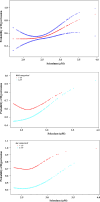Exploring the potential association between serum selenium and hypertension in obese adult males in the United States
- PMID: 39779781
- PMCID: PMC11711189
- DOI: 10.1038/s41598-025-85343-1
Exploring the potential association between serum selenium and hypertension in obese adult males in the United States
Abstract
Previous studies on the correlation between serum selenium and hypertension have yielded inconsistent results. Our previous analysis of participants from the National Health and Nutrition Examination Survey (NHANES) 2011-2018 indicated that elevated serum selenium concentrations were associated with an increased risk of metabolic abnormalities in obese individuals, with the primary effect being on blood pressure in males. The aim of this study was to further elucidate the relationship between serum selenium and the risk of hypertension in obese males. In this study, we examined the correlation between serum selenium concentrations and hypertension in 2,585 male participants with a body mass index (BMI) ≥ 30 kg/m2 aged between 20 and 80 years from the 2011-2018 NHANES database. The associations between serum selenium levels and hypertension were evaluated through weighted generalized linear regression analyses. To examine the saturation threshold effect between serum selenium and hypertension, a generalized additive model (GAM) and a two-piecewise linear regression model were employed. Furthermore, the saturation threshold effect was evaluated separately in subgroups stratified by BMI and age. The weighted prevalence of hypertension (51.84%) was slightly higher than that of nonhypertension (48.16%) in the participants included in this study. After rigorous adjustment for sociodemographic, physical, and laboratory test covariates, the weighted odds ratio (OR) of hypertension increased by 103% for every 1 standard deviation (SD) increase (approximately 24.41 µg) in the serum selenium concentration in participants assigned to the highest serum selenium group (weighted OR = 2.03; 95% CI = 1.24-3.32; P = 0.013). A calculation was subsequently performed to determine the saturation threshold effect of selenium on hypertension among participants in the medium and highest selenium concentration subgroups. The findings indicated that participants with serum selenium concentrations exceeding the saturation threshold (2.56 µM) demonstrated an elevated risk of developing hypertension (weighted OR = 9.58; 95% CI = 2.74-33.46; P = 0.000) in comparison to those with serum selenium concentrations below the threshold. Subgroup analyses demonstrated that serum selenium concentrations exceeding the saturation threshold were associated with an increased risk of hypertension in participants with a BMI ≤ 35 kg/m2 (weighted OR = 9.11; 95% CI = 1.43-58.24; P = 0.030) or those aged less than 55 years or younger (weighted OR = 8.37; 95% CI = 1.71-40.94; P = 0.014). For obese adult males who require additional selenium supplementation to enhancing their overall health and well-being, it is strongly recommended that the serum selenium concentrations be monitored throughout the course of supplementation to ensure that they remain within the relatively safe range (approximately less than 215.75 µg/L).
Keywords: Body mass index (BMI); Hypertension; National Health and Nutrition Examination Survey (NHANES); Obesity; Serum selenium; Z-score.
© 2025. The Author(s).
Conflict of interest statement
Declarations. Competing interests: The authors declare no competing interests.
Figures


References
Publication types
MeSH terms
Substances
Grants and funding
LinkOut - more resources
Full Text Sources
Medical

